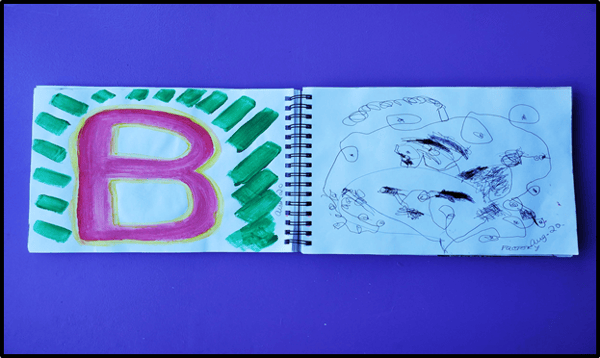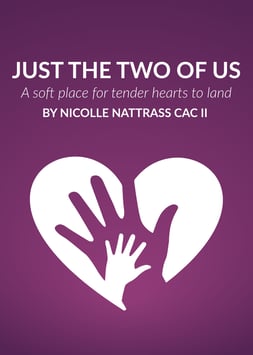Do you parent or care for children who have experienced stress, worry, anxiety or trauma?
Just Two of Us (a soft place for tender hearts to land) is a new book, a tender-hearted guide on how to use Creative Journaling as a key recovery tool to help children (age 4 and up) to connect and process stress, anxiety, trauma. Young children need a soft place to land when feelings are too much, and words are not enough.
This book is a trauma-informed approach to using Creative Journaling with children to help heal, build resilience, increase joy and develop mental and emotional well-being.
As I write this blog, on New Year’s Eve, I am journaling my way into 2021, landing on the page, to process and reflect upon this past year. Without question, correction or instruction, the journal is my soft place to land, both outlet, window and container for me to lay what I need down on the page. Through-out my personal and professional life as an Addictions Counselor CAC II, I have used journaling to navigate my own self care as well as developing specific courses for professionals, clients and organizations to help others access and benefit from this powerful, healing tool.
Writing this book had been in the back of my mind since 2017 but when the pandemic, Covid-19 hit, I felt compelled to. The time was now to release this book, as children’s worlds were shifting rapidly, with school closures, recreational activities cancelled, quarantine, social distancing, not to mention the added increase of stress, trauma and pressure for adult caregivers, parents and helping professionals. I felt it was a necessity to offer an outlet other than more screen time & technology for children to use, an outlet which can easily interfere with a child’s sense of connection and attachment. As a counselor I knew that I could offer accessible, alternative solutions for parents to help children soothe, relieve stress, process anxiety, provide enjoyment and increase emotional wellness. I wrote and released a sample chapter to those in my circle, personally and professionally and the response I received fueled me to complete the book and within 4 months, it was written and published Sept.14/2020. (The Zebra Ink, NY. USA.)
The book offers more than a culmination of my professional experience using journaling as a counselor with clients. I came to this “tender-hearted work” after having to face what no parent expects to face: witnessing the effects of trauma on their child.
In 2013, our family experienced a very traumatic motor vehicle accident when our son was four years old. Thankfully, he was not physically injured save for a small cut and bruising from the straps on his car seat that kept him safely in place. However, the emotional and mental impact was significantly life-changing, enough that there was no way we could ignore it or chalk it up as an unfortunate event best forgotten. Despite well-meaning suggestions to “try not to talk about the car accident and that maybe he would forget about it in a couple of weeks,” we could not and did not.
He was sending out disturbing signals. For example, in his play he was building towers in places where they were sure to be knocked down in passing or placing them in close proximity to our front door. When they did fall over, the emotional distress he displayed was more than a normal response. I began paying closer attention, having been trained to notice signs and symptoms of PTSD when I worked as a frontline addiction counselor in residential treatment.
Concerned, I searched everywhere and found different resources, including the National Child Trauma Network. I looked at the recommendations there, looking for services suitable for children and began to ask around in my community about what might help. As I researched what help was available, I realized, both as a parent and therapeutic counseling professional, the very real limitations for helping children who were too young for talk therapy but who were in need of support. It was clear that not only were resources limited and/or not age-appropriate. I was not comfortable leaving my child alone in a session with anyone at this time as he was experiencing separation anxiety. Many of the existing resources that could help him were far away in bigger cities, requiring travel in the car.
The time after the car accident had become increasingly difficult for all of us. We were fortunate to find a play therapist and we began attending sessions. Even after some physical healing and therapy were firmly in place, increased stress and anxiety in our home was the new normal. On one particularly challenging day at home, I pulled out a large blank journal and grabbed whatever was nearby, my son’s crayons, and opened the page. My son sat next to me and I pointed to one side of the page as his and the other as mine.
This is how this tender-hearted work began.
The gift of this experience for children is to provide a place to allow the full expression of their feelings, whatever they might be, either joyful or traumatic. The journal is a grounding tool that provides a safe outlet to make sense of their world and enables a concrete experiential language to surface. When my son’s anxiety was high or either one of us was having a challenging time, we ended up at the kitchen table with the journal spread out between us. With little or no words, we explored and put whatever came up onto the blank page.
As we interacted together, I realized that even as an avid journal keeper myself, I didn’t feel that I could write about the effects of the accident. I believe that this feeling of not being able to put one’s traumatic experience into words is present in degrees for all of us, even more so for children.
This journal became our recorder, our witness, our companion when we traveled, our entertainer when we were out eating a meal in a restaurant and much more. It became a soft place to land, to rest, and to lay what we needed on the page, without question, correction or judgement.
That last sentence is key.
Creative Journaling offers an experiential hands-on activity that can be an outlet to restore mental and emotional health, stimulate creative imagination and open up an interaction where conversation can emerge. Scientific research has proven very clearly that journaling is beneficial to our mental and physical health by reducing stress.
As I close this blog, I want to share with you a journal entry, an example from the book and from my own parenting experience using journaling.
 Journal Entry: August 20/2014/ Age 5
Journal Entry: August 20/2014/ Age 5
The above photo: This journal entry happened on a day where we could not find our cat, Ben. We spent a few fretful hours working through anxiety and searching for Ben. I took the lead to bring the journal to the kitchen table as I realized that no amount of words were able to console or change the situation or how my son was feeling. As a parent, I chose to bring out paints and simply to lay a B on the page. This focused our energy. I kept adding to the letter “B” with different layers and colours as we talked through what was going on. There was frustration, fear and many tears that day. This page was later referred to as “This is the day Ben was lost and came home again.”
My book is filled with journal examples like this that help to illustrate the process from both a parent and counseling lens. Creative Journaling is an accessible, positive healthy tool that builds connection, increases communication and emotional intelligence by helping children to identify and channel their feelings and thoughts while increasing creativity. It provides a safe place for children to trust, relieve stress, fears, anxiety, worry and trauma.
This 40 page book is now available in bookstores and you can purchase a digital copy here. If you are curious about Journaling for your own self-care, I encourage you to explore my online offerings here.
Wishing you a Happy New Year and hope to connect with you in 2021. Until then, take care of tender hearts, including your own.
 Author bio: Nicolle Nattrass CAC II
Author bio: Nicolle Nattrass CAC II
Nicolle Nattrass’s professional expertise is a result of her distinct and unique careers in Counselling, Theatre, Writing and Teaching. She is a Certified Addiction Counsellor CAC II and BFA graduate from University of Victoria in Theatre. Nicolle is proud to be part of the IAJW Journal Council with the International Association for Journaling Writing. She is also a Jessie Award nominated actress (CAEA), playwright (PGC), and contributing author of the forthcoming new book, Transformational Journaling for Coaches & Clients: The Complete Guide to the Benefits of Personal Writing (Routledge, 2021) by Lynda Monk & Eric Maisel (Eds.). Nicolle is the author of four Creative Journaling courses. She has recently published her first book, Just the Two of Us (a soft place for tender hearts to land), a tender-hearted guide on how to use Creative Journaling as a key recovery tool to help children (age 4 and up) to connect and
process stress, anxiety and trauma. A dedicated counsellor and consultant in personal and professional creative self-care, she believes in carrying a message to empower others through her work, whether it is as an actor, writer or as Addiction counselor. Nicolle is a champion for self-care and artistic expression with the focus on ENJOYMENT! She creates courses & workbooks that are easy to use, powerful and inspiring. Nicolle strives to offer a balance of guidance and freedom for her journaling clients, “no rules but opportunities to tune in for self- care to transform and move forward to the next step in your journey.” Nicolle is the author of our IAJW course, Creative Journaling for Self-Care – which is currently on sale until Jan. 12/2021, check it out here.




Leave Comment